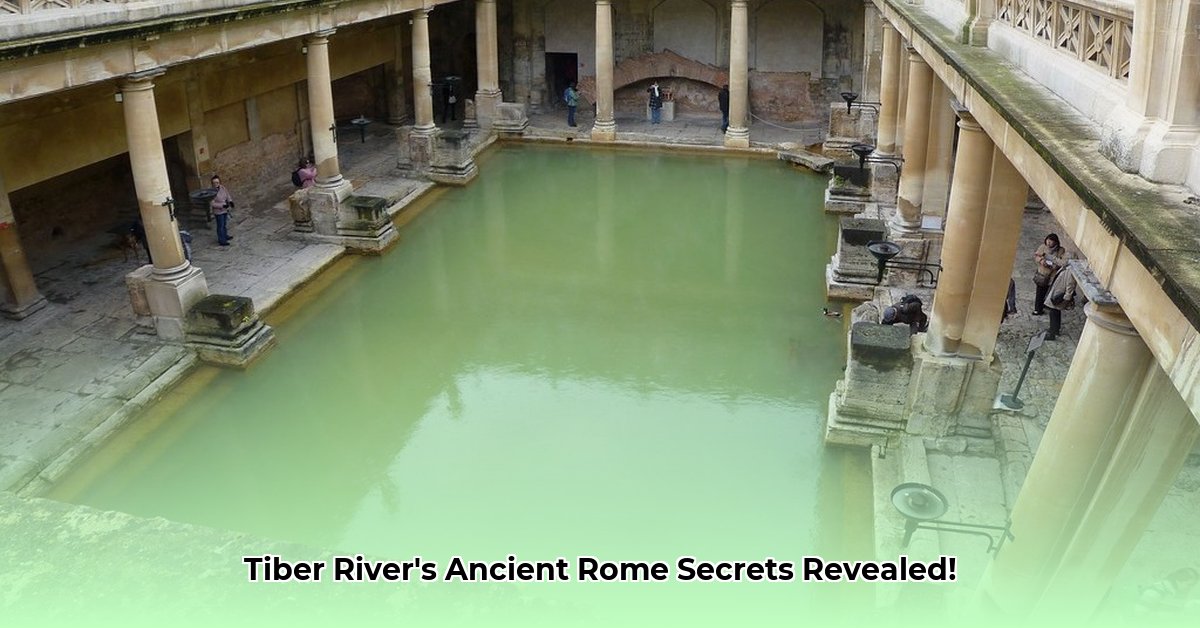Ever wondered what truly made Ancient Rome not just survive, but thrive? Beyond the legions and emperors, behind the monumental architecture, lay its most critical asset: the Tiber River. Far more than a mere geographical feature, this mighty waterway was the lifeblood of an empire, shaping its very genesis, sustaining its growth, and challenging its ingenious spirit. Learn more with an Ancient Rome map. Join us on an immersive journey to uncover the profound ways the Tiber inextricably wove itself into the fabric of Roman civilization, from its pivotal role in foundational myths to the relentless engineering battles waged against its unpredictable currents. Prepare to see the Eternal City in a new light, flowing, quite literally, from the heart of the Tiber.
The Tiber: Rome’s Indispensable Artery
The connection between the Tiber River and Ancient Rome is undeniably profound. It’s almost impossible to conceive of the vast Roman Empire without acknowledging the indispensable role played by this winding serpentine river. Rising in the Apennine Mountains in Emilia-Romagna, the Tiber flows 406 kilometers (252 miles) through Tuscany, Umbria, and Lazio, eventually meeting the Tyrrhenian Sea between Ostia and Fiumicino. Draining a basin estimated at 17,375 square kilometers (6,709 square miles), it was not merely a natural boundary or a scenic backdrop; it was the dynamic force that influenced every aspect of Roman life, from its earliest settlements to its sprawling trade networks and sophisticated urban development.
Rome’s Foundational Flow: Resources and Strategic Resilience
The very sustenance of early Rome depended on a reliable source of fresh water, a role the Tiber fulfilled perfectly. Its waters provided essential drinking supply for its burgeoning population and were channeled by farmers to irrigate vital crops in the surrounding fertile plains. Beyond basic utility, the river also served as a critical component of Rome’s public health infrastructure. The famous Cloaca Maxima, an ancient Roman sewer system, ingeniously utilized the river’s flow to carry wastewater away from the city center, a pragmatic solution crucial for urban sanitation.
Strategically, the Tiber offered a natural defensive barrier, a watery shield that helped fortify early Rome against invaders. For any forces approaching from the east, the river presented a formidable obstacle, allowing Roman settlements on the western bank a degree of protection. Crucially, Rome’s control of Ostia, its ancient port at the Tiber’s mouth, provided direct access to the Tyrrhenian Sea. This control was instrumental in forging Rome’s growing naval power, which ultimately transformed the Mediterranean into a virtual Roman lake, securing dominance over crucial trade routes and military movements. The Tiber itself became a bustling aquatic highway, connecting Rome to its expanding territories and beyond. Essential resources like timber and massive stone blocks for construction, along with foodstuffs such as grain, olive oil, and wine, flowed into the city from colonies across the Mediterranean. This natural conduit was vital, enabling Rome’s monumental growth and showcasing remarkable resource management for its era.
Myth, Divinity, and the Tiber’s Cultural Roots
No great civilization is complete without a powerful founding myth, and the story of Ancient Rome is inextricably entwined with the Tiber. The legendary twin founders, Romulus and Remus, are said to have been abandoned on its banks, only to be famously rescued by a she-wolf, Lupa. This powerful imagery forever etched the river into Rome’s very beginnings. The Romans, recognizing the river’s profound significance, eventually deified it, personifying it as Tiberinus (also known as Tiber Pater or Volturnus), a powerful river deity. Temples were built in his honor, solidifying the river’s spiritual importance.
The legend of King Tiberinus, ninth in the king-list of Alba Longa, who allegedly drowned in the River Albula (itself named for the whitish hue of the Tiber’s sediment), led to the river being renamed Tiberis. Even today, the phrase “swimming the Tiber” or “crossing the Tiber” endures as a powerful metaphor for converting to Roman Catholicism, while “swimming the Thames” implies conversion to Anglicanism. This enduring idiom is a testament to the river’s lasting cultural impact and its deep connection to Roman identity. Furthermore, the Tiber served a grim but significant role in Roman society: executed criminals, including those from the notorious Gemonian stairs, were often thrown into its waters, a practice that continued for centuries, even seeing the corpse of Pope Formosus cast into the river after the infamous Cadaver Synod in 897 CE.
Taming the Waters: Ancient Rome’s Persistent Battle with the Tiber’s Floods
Life alongside the Tiber was not without formidable challenges. The river, while a source of life, also threatened devastation. Frequent and often catastrophic floods left an indelible mark on the city and its people, shaping its social, economic, and physical structure. Ancient literary accounts paint vivid pictures of these inundations, dating back as early as 414 BCE. Imagine the chaos, the fear, and the sheer destructive power of water surging through the bustling streets of Rome. These floods were not mere inconveniences; they were a constant, looming threat to the very fabric of Roman civilization, impacting everything from daily life to long-term urban development and public health.
The Tiber’s Unpredictable Power: A Dual-Natured Force
The Tiber’s flooding was a persistent, recurring problem. While the flat Campus Martius area was a natural floodplain, regularly submerging to depths of 2 meters (6 feet 7 inches), major floods could be far more destructive. Records detail devastating events, such as the September 15, 1557 flood when the river reached 19 meters (62 feet) above sea level, claiming over 1,000 lives. Another catastrophic flood occurred in 1598, with the water rising almost 20 meters, submerging large parts of the city including the densely populated Jewish quarter. Decades later, the 1870 flood, just months after Rome became the capital of a unified Italy, saw water levels reach 17.22 meters, bringing sewage, mud, and disease into populous areas like Piazza del Popolo and Via del Corso.
Several factors contributed to the Tiber’s volatile nature. Extensive deforestation in its upper basin meant fewer trees to absorb rainfall, leading to increased runoff and more rapid surges. Furthermore, Rome’s rapid urbanization saw buildings and infrastructure encroaching upon the river’s natural floodplain, exacerbating the problem. This interplay between natural processes and human activity provides early lessons in environmental sustainability and the unintended consequences of unchecked expansion.
Roman Ingenuity and Adaptive Measures
The Romans, renowned for their pragmatism and engineering prowess, did not simply succumb to the river’s fury. They developed impressive strategies to mitigate the impact of floods:
- Hydraulic Engineering Marvels: The Cloaca Maxima, initially an open canal built around 600 BCE to drain the swampland between the Palatine and Capitoline hills, stands as a testament to early Roman hydraulic engineering. While primarily a sewer system, it also helped manage some floodwaters, though its effectiveness was limited by backflow during major inundations. Later, the Romans built an extensive underground network of tunnels and channels to bring clean water into the city.
- Adaptive Urban Planning: Roman architects and urban planners understood the river’s temperament. Buildings were often constructed on higher ground, and flood-resistant materials like pozzolanic concrete were utilized. While these solutions were not always foolproof, they represented a conscious, ongoing effort to adapt to their challenging environment.
- Resource and Disaster Management: The Romans established horrea, vast public grain warehouses, to store surplus food. These vital facilities acted as a crucial buffer against the food shortages that frequently followed major floods, demonstrating an early form of disaster management geared towards ensuring public safety and resource availability.
- Modern Embankments: Despite their ancient efforts, complete flood control remained elusive. It was not until the late 19th century that a lasting solution began to take shape. Following the devastating 1870 flood, engineers like Raffaele Canevari proposed building massive travertine embankment walls, known as muraglioni. Construction began in 1876 and continued until 1910, creating colossal walls 17 to 18 meters high and spaced 100 meters apart along the river’s banks within the city. This monumental project required the demolition of many historic buildings, especially in Rome’s Jewish quarter, and parts of the Aurelian Walls, permanently altering the cityscape but largely taming the Tiber’s floods. These embankments are still a prominent feature today, forming the lungoteveri, boulevards that line the river.
Societal Impact and Enduring Lessons
The impact of floods was multifaceted and far-reaching. They disrupted daily life, transforming bustling streets into impassable waterways. Homes and businesses suffered immense damage, leaving countless Romans displaced and destitute. Disease, particularly waterborne illnesses, spread rapidly in stagnant floodwaters, adding to the misery. While the wealthy could often afford to rebuild or relocate, the lower classes disproportionately bore the brunt of the devastation. They resided in more vulnerable areas and possessed fewer resources for recovery. The Tiber’s fury, therefore, exposed and often exacerbated the stark social inequalities within Ancient Rome.
Despite lacking modern technology, the Romans demonstrated remarkable resilience and adaptability in the face of recurring floods. Their efforts to manage water flow, build resilient infrastructure, and ensure food security offer invaluable insights for contemporary urban planners and disaster management professionals. The Roman experience teaches us that true societal resilience lies not just in engineering solutions, but in a comprehensive approach that addresses social equity and environmental sustainability. Living with a powerful force of nature like the Tiber required constant vigilance and a willingness to adapt, a lesson that resonates across millennia.
The Tiber’s Lasting Legacy: From Antiquity to Modern Rome
The Tiber River’s influence extends far beyond the annals of ancient history, resonating through idioms, modern religious practices, and the very urban layout of contemporary Rome. Its impact is undeniably woven into the fabric of the city, a testament to its enduring significance. From its mythological origins to its practical applications, the Tiber left an indelible mark on one of history’s greatest civilizations.
A River Through Time: Evolution and Modern Echoes
The Tiber’s importance as a navigable waterway waxed and waned throughout history. While ships could reportedly reach up to 100 kilometers (60 miles) upstream in ancient times, silting became a persistent problem. This heavy sedimentation made maintaining the ancient port of Ostia increasingly difficult, prompting emperors Claudius and Trajan to establish new ports on the Fiumicino branch in the first century CE, connecting them to Rome via the Via Portuensis. Despite various popes attempting to improve navigation in the 17th and 18th centuries through extensive dredging, silting continued. By the 20th century, the river was only reliably navigable as far as Rome itself, and the Tiber delta had advanced approximately 3 kilometers (2 miles) seaward since Roman times, leaving Ostia Antica 6 kilometers (4 miles) inland.
Despite these challenges, the Tiber remained, and still remains, a vital fresh water source for Rome. Its yellowish-whitish color, due to sediment, even earned it the nickname “flavus” (meaning “white” or “yellowish”) from the ancient Romans. Today, the river’s banks are lined with popular boulevards, the lungoteveri, offering scenic routes for walking and biking.
Iconic Crossings and Cultural Touchstones
Rome’s profound interaction with the Tiber is perhaps best symbolized by its numerous bridges, both ancient and modern. While many modern crossings now span the river, several ancient bridges have remarkably survived, often as pedestrian-only pathways. Among these are the iconic Ponte Milvio (Milvian Bridge), dating back to 109 BCE, and the Ponte Sant’Angelo (Hadrian’s Bridge), built in the 2nd century CE, leading directly to Castel Sant’Angelo. Other notable survivors include the Pons Fabricius and Pons Cestius, which connect each side of Tiber Island to the riverbanks.
Tiber Island itself, nestled in the center of the river between Trastevere and the ancient city center, holds immense historical and symbolic significance. Once the site of an important ancient ford, it was later bridged and became home to the Basilica of St. Bartholomew. From a bird’s-eye view, the island is said to resemble a fishing boat, further adding to its unique charm.
The Tiber continues to be a focal point for Roman life and traditions. Each New Year’s Day, courageous Romans partake in a daring tradition of diving into the cold Tiber waters from Ponte Cavour, a testament to the river’s enduring connection to Roman identity and resilience. For visitors, serene river cruises offer a unique perspective of the city, gliding past iconic landmarks like Castel Sant’Angelo and Vatican City, providing a break from the bustling city traffic and a chance to experience Rome’s story from its watery heart. The Tiber River truly is a timeless echo, consistently shaping and reflecting the Eternal City through millennia.










